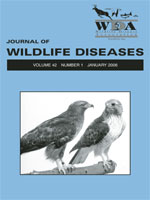We studied the effects of natural and/or experimental infections of West Nile virus (WNV) in five raptor species from July 2002 to March 2004, including American kestrels (Falco sparverius), golden eagles (Aquila chrysaetos), red-tailed hawks (Buteo jamaicensis), barn owls (Tyto alba), and great horned owls (Bubo virginianus). Birds were infected per mosquito bite, per os, or percutaneously by needle. Many experimentally infected birds developed mosquito-infectious levels of viremia (>105 WNV plaque forming units per ml serum) within5 days postinoculation (DPI), and/or shed virus per os or per cloaca. Infection of organs 15–27 days postinoculation was infrequently detected by virus isolation from spleen, kidney, skin, heart, brain, and eye in convalescent birds. Histopathologic findings varied among species and by method of infection. The most common histopathologic lesions were subacute myocarditis and encephalitis. Several birds had a more acute, severe disease condition represented by arteritis and associated with tissue degeneration and necrosis. This study demonstrates that raptor species vary in their response to WNV infection and that several modes of exposure (e.g., oral) may result in infection. Wildlife managers should recognize that, although many WNV infections are sublethal to raptors, subacute lesions could potentially reduce viability of populations. We recommend that raptor handlers consider raptors as a potential source of WNV contamination due to oral and cloacal shedding.
How to translate text using browser tools
1 January 2006
NATURAL AND EXPERIMENTAL WEST NILE VIRUS INFECTION IN FIVE RAPTOR SPECIES
Nicole Nemeth,
Daniel Gould,
Richard Bowen,
Nicholas Komar

Journal of Wildlife Diseases
Vol. 42 • No. 1
January 2006
Vol. 42 • No. 1
January 2006
American kestrel
barn owl
experimental infection
golden eagle
great horned owl
histopathology
raptors




